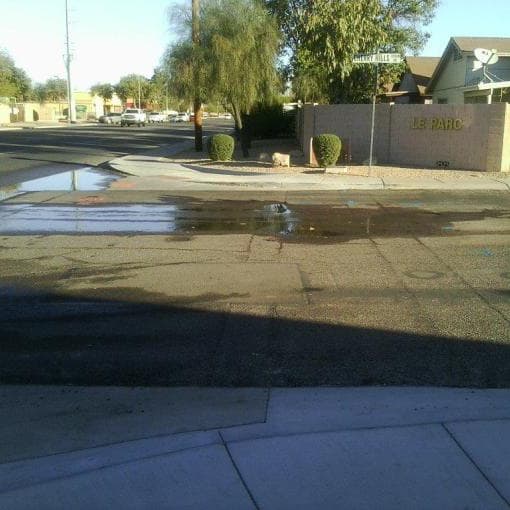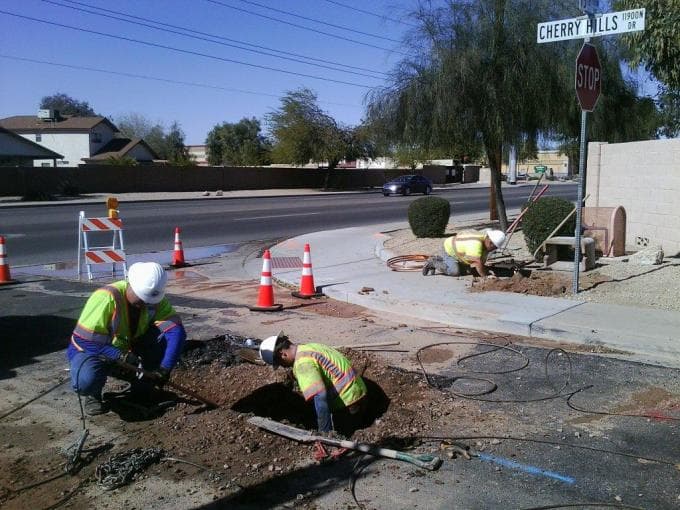AMWUA Blog
BY: Warren TenneyFollow Your City’s Lead: Find And Fix Leaks

Every day millions of gallons of treated drinking water course through miles of pipes buried deep under our feet. The water circulates through tanks and pumps we never notice and through service lines that run to our water meters and finally into our homes.
Drinking water is such a precious commodity that cities invest enormous amounts of money and time preventing, detecting and fixing leaks in water infrastructure.
By law, large water providers in Arizona must limit the water lost in their delivery systems to 10 percent. "Lost and unaccounted for" water includes billing and metering inaccuracies, theft, and evaporation from storage tanks and ponds, as well as leaks or breaks in the distribution system. From 2009 through 2013, AMWUA member cities averaged a loss of 6.91 percent. Many maintain loss ratios that are significantly lower.
The City of Peoria has one large drinking water treatment plant, 924 miles of drinking water distribution lines, 44 wells and 46 storage tanks or reservoirs. Peoria also receives treated water from the City of Glendale’s Pyramid Peak Water Treatment Plant. That adds up to a lot of possibilities for leaks and breaks, but Peoria keeps its lost and unaccounted for water to under 5 percent a year. Here are some of the tools Peoria and other cities use to prevent and detect leaks.
SCADA: Peoria uses a computer program called Supervisory Control and Data Acquisition or SCADA to track water throughout its system. The program allows City employees to keep their eyes on each part of the water distribution system remotely and in real time. The City’s water department calls it “a living, breathing animal” that is customized and fine-tuned to communicate second-by-second changes in the system.
Operators use the program to review water distribution pumps every hour looking for subtle signs of a problem. The system also sends out automated alerts when it detects an obvious change in a distribution pump, such as a large drop or spike in pressure or when an out-of-service pump unexpectedly turns on. For example, a sudden change in pressure could mean firefighters need high volume and pressure to put out a fire, a construction site is filling a large water tank, a reservoir is overflowing or there is a break in the system and the City is losing water.
Field Inspections: The City doesn’t depend solely on the computer program to monitor its drinking water system. Employees also make regular onsite field inspections of the water distribution system. If the computer program is interrupted, these employees can be on a site within minutes to monitor the system for leaks or other problems and make any needed adjustments as the water continues to flow.
Pressure Valves: Valves turn water on and off to particular pumps as customer demand requires. The City uses valves that slowly release the water so it flows gently into the distribution system. If these valves opened instantly, the water pressure they’d release would put stress on pipes and weaken them and leave them more vulnerable to leaks.
Tracking: Pipes have a limited life expectancy. Every city needs a plan and funding for timely replacement of this critical infrastructure and to avoid expensive emergency repairs and disruption in service to customers. The City tracks every big and small leak that is detected and repaired and uses the information to create a map. The map acts as a guide to help the City determine which pipes need to be replaced first.
Sounding Equipment: Leaks are not always easy to find, particularly if the leak is under a busy intersection where there are several layers of pipes as deep as 15 feet. That’s when the city calls in a contractor with special sound equipment that operates like a giant stethoscope and allows the contractor to hear and pinpoint the leak. Peoria is a young city with newer infrastructure, so this happens only once every five or 10 years.

Once water reaches a residential meter, cities count on homeowners to find and fix household leaks. Small leaks can add up quickly, waste water, and cost homeowners money. U.S. Environmental Protection Agency research shows the average home can lose up to 10,000 gallons of drinking water a year because of leaks. These leaks occur in fixtures, such as toilets and faucets, and in broken drip lines and sprinkler heads in irrigation systems.
That’s why the EPA and its partners set aside this week each year as Fix a Leak Week and encourages people to find and fix leaks.

To make that task easier, water conservation professionals from the 10 AMWUA member cities pooled their expert knowledge and created the Smart Home Water Guide website (in Spanish, Guia Para Detectar Fugas ). The mobile-friendly website walks the owner step-by-step through the process of tracking down leaks and provides links to helpful DIY repair videos. The Smart Home Water Guide also is available as a 24-page booklet in both Spanish and English. Check with your city's water department for copies.
Fix a Leak Week is a good time to replace a washer on a leaky faucet or a valve on a running toilet, to invest in new sprinkler heads or replace cracked drip lines. Reducing leaks, whether in expansive water distribution systems or in our homes, saves money and preserves water for the future.
For 46 years, Arizona Municipal Water Users Association has worked to protect our member cities’ ability to provide assured, safe and sustainable water supplies to their communities. For more water information visit www.amwua.org .
